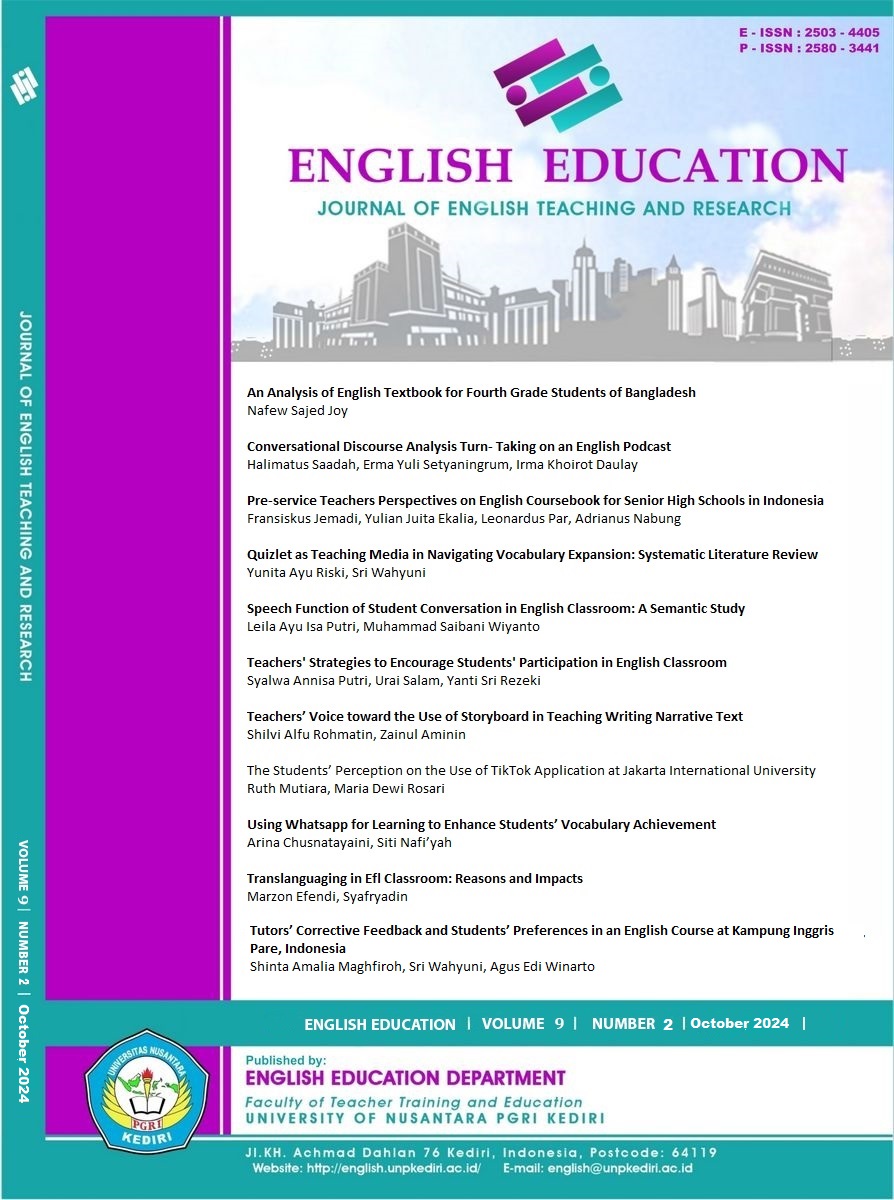Tutors’ Corrective Feedback and Students’ Preferences in an English Course at Kampung Inggris Pare, Indonesia
DOI:
https://doi.org/10.29407/jetar.v9i2.21592Keywords:
Oral Corrective Feedback; Students’ Preferences; Speaking skill., Students’ Preferences, Oral Corrective Feedback, Speaking skillAbstract
This study aimed to identify the kinds of corrective feedback that tutors and students most frequently utilize. The research design used in this study was qualitative, involving 2 English tutors and 25 students from an English course institution. To collect data, the researcher conducted observation to observe 6 class interaction meetings. Then, the researcher distributed Google form questionnaires to students via WhatsApp and interviewed two tutors. Data analysis began with summarizing and then displaying, reducing, and displaying. The last step was to interpret and represent the data. The results showed that English tutors in Kampung Inggris give recasts more often than other corrective feedback due to the students' tendency to receive corrective feedback. However, two corrective feedback were often used after recast: repetition and paralinguistic. Unfortunately, these two types of corrective feedback are not very favorable to students. In fact, almost half the number of participants disagree (40%) and (44%), respectively. This needs to be considered by teachers to minimize misunderstandings, maximize the learning process, and improve students' speaking skills without making students depressed and offended by getting corrective feedback.
Downloads
References
Didik Hartono, Yazid Basthomi, Oktavia Widiastuti & Santi Prastiyowati. (2022). The Impacts of Teacher’s Oral Corrective Feedback to Students’ Psychological Domain:A Study on EFL Speech Production, Cogent Education, 9:1
Ellis, R. (2009). Corrective Feedback and Teacher Development. L2 Journal 1.
Ellis, R. (2017). Oral corrective feedback in L2 classrooms: What we know so far. In H. Nassaji & E. Kartchava (Eds.), Corrective feedback in second language teaching and learning (1st ed., p. 16). New York: Routledge.
Fadhillah, A. E. (2017). EFL Students’ Preferences for Oral Corrective Feedback in Speaking Instruction: Jurnal Pendidikan Humaniora, Volume 5, Number 2.
Ha, Xuan V., Nguyen, Loc T and Hung, Bui Phu. (2021). Oral corrective feedback in English as a foreign language classrooms: A teaching and learning perspective. Heliyon. Vol 7
Laeli, A. F., & Setiawan, S. (2019). Oral Corrective Feedback in Speaking Class: Its Frequency, Students' Perceptions, and Preference. Exposure: Jurnal Pendidikan Bahasa Inggris, 8(2), 257.
Li, F., Feng, Z. & Hou, Y. (2020). Case Study on Effectiveness of Oral Corrective Feedback in the Second Language Classrooms in Second Language Acquisition: International Journal of Arts and Commerce, 9(7), 22-29.
Miles, M. B., & Huberman, A. M. (1994). Qualitative Data Analysis: An Expanded Sourcebook. Thousand Oaks, CA: Sage Publications
Maizola, S. (2016). Teachers’ Oral Corrective Feedbak on Students’ Dialogue Performance at Senior High School PGRI 1 Padang. A thesis in College of Teacher Training and Education (STKIP) PGRI Padang.
Mulyani, sri. et al. (2022). Student’s perceptions toward oral corrective feedback in a speaking class. Eternal. Vol 8 no.1. https://doi.org/10.24252/Eternal.V81.2022.A12
Ounis Tesnim. (2019). Oral Corrective Feedback and Its Impact on Learners’ Speaking Skills: Tunisian EFL Students as a Case Study. International Journal of Language and Linguistics. Vol. 7, No. 3 pp. 138-149.
Rahimi, M. & Sobhani, A. (2015). Teachers‟ Different Types of Feedback on Iranian EFL learners “Speaking Errors and Their Impact on the Students” Uptake of The Correct Forms. Research Papers in Language Teaching and Learning. Holonic Open University: ISSN.
Syakira, S., Sahril Nur. (2021). Learners' Perceptions on the Use of Oral Corrective Feedback in One-to-One EFL Classroom. Eralingua: Jurnal Pendidikan Bahasa Asing dan Sastra. Vol.6, No.2.
Downloads
Published
Issue
Section
License
Authors who publish with this journal agree to the following terms:
- Copyright on any article is retained by the author(s).
- The author grants the journal, the right of first publication with the work simultaneously licensed under a Creative Commons Attribution License that allows others to share the work with an acknowledgment of the work’s authorship and initial publication in this journal.
- Authors are able to enter into separate, additional contractual arrangements for the non-exclusive distribution of the journal’s published version of the work (e.g., post it to an institutional repository or publish it in a book), with an acknowledgment of its initial publication in this journal.
- Authors are permitted and encouraged to post their work online (e.g., in institutional repositories or on their website) prior to and during the submission process, as it can lead to productive exchanges, as well as earlier and greater citation of published work.
- The article and any associated published material is distributed under the Creative Commons Attribution-ShareAlike 4.0 International License








 Article template
Article template



